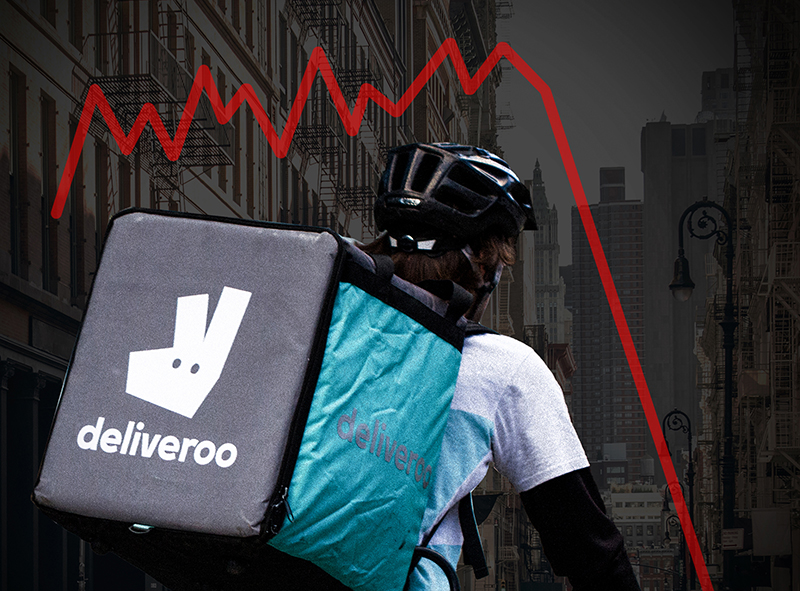Deliveroo’s long-awaited trading debut on the London Stock Exchange can be labelled as one of the weakest in stock market history. After months of planning, drama and speculation, Deliveroo’s stock sank by 30% on its very first trading day, making it a poor first-day performance for a sizeable London IPO (above £1 billion) and yet another big name to fall short on achieving its initial target valuation. In a nutshell, its start to life as a public company was definitely not what this tech giant had first expected.
So, where did it all go wrong for the Deliveroo IPO? What caused Deliveroo’s underwhelming stock market debut? And what does this mean for the London Stock Exchange as a whole? Below, Maxim Manturov, Head of Investment Research at Freedom Finance Europe, dives deeper into Deliveroo’s shares plunge, the reasons behind this downfall and the future outlook for the now-public company.
Why did investors turn down the Deliveroo IPO?
There are three core reasons that investors chose not to invest in the Deliveroo IPO on its trading debut. Firstly, the stock has a dual-class structure, which means the CEO still has control over the business. Secondly, employee categorisation and the conflict regarding the staff conditions for delivery workers. And finally, higher US Treasury bond yields, which cause rotation of rising stocks, the latter two being local issues.
As for the stock’s dual-class structure, this had a clear negative impact on attracting domestic and large-scale investors to the Deliveroo IPO. For example, the likes of Aberdeen Standard Life, Aviva, Legal & General Investment Management and M&G opted out of this particular investment due to concerns overpower. With Deliveroo CEO, Will Shu, retaining 57% of voting rights, there was a clear imbalance of control between shareholders and management.[1] Ultimately, shareholders feared this structure would leave them with little to no protection, as the company did not qualify for a premium listing.
Following on from this, employee categorisation and the growing conflict over workers’ rights are other key factors that led to the failure of Deliveroo’s trading debut. Previously, Uber faced a similar issue regarding employee categorisation. The UK Supreme Court acknowledged Uber drivers as employees that are eligible for minimum wages, paid vacation and retirement pension. This same ruling proves critical for Deliveroo as, on the one hand, making riders full employees is likely to prevent the company from breaking even as soon as possible and could even impact its ability to continue operating. While on the other hand, big investors are shunning the tech giant over its outlook on workers’ rights.
There is also the social media backlash to consider, with many people posting across their various social media platforms about large-scale investors refraining from taking part in the Deliveroo IPO. Alongside this, there was the mass uproar around the delivery workers' protests and corporate governance, which led to a negative news background ahead of the IPO and a significant decrease in its initial target valuation. The growing power of social media is definitely something for companies to watch out for in the coming years, as most people carry mobile devices and check their media feeds 24/7.
Lastly, US Treasury bond yields rose in March, which led to growth stock rotation and a significant decrease in Deliveroo share prices. This shortfall, unfortunately, occurred at a very problematic time and, in turn, meant investors were less likely to invest in the Deliveroo IPO on its trading debut. In fact, many of Deliveroo’s key competitors suffered a loss due to higher US Treasury bond yields, with DoorDash shares losing as much as 23% since the beginning of March.
The impact on the London Stock Exchange
When looking at the bigger picture, the overall impact of Deliveroo’s trading debut on the UK stock market is pretty insignificant. The London Stock Exchange is still working on easing listing regulations and attracting fast-growth tech companies and ultimately seems pretty unphased by this unfortunate setback. For example, Darktrace, a cybersecurity startup, heads for the FTSE with a £3 billion IPO plan on the London Stock Exchange, and there is a long list of exciting IPOs set to follow in its footsteps.[2]
Analysts also report that Deliveroo's bad start does not have to do much with the UK stock market itself. Instead, the reasons are primarily internal issues, namely the employee categorisation issue. Therefore, Deliveroo's failure is very unlikely to have a huge impact on overall listings going forward, but the London Stock Exchange does need to ensure the next tech IPO to hit the market makes everyone forget about Deliveroo’s underwhelming start.
The future for Deliveroo
While a 30% fall in shares is, of course, not the worst start in stock market history, it is one of the weakest in the London Stock Exchange over the last decade. That being said, the company still managed to raise a substantial amount from retail investors and in Q1 2021, the uptrend was there to stay, with 71 million orders against 33 million last year, and the overall transaction value rising by 130% YoY to reach £1.65 billion.[3]
It is also important to note that the volatility faced by Deliveroo is likely to be temporary, as fundamentally the tech giant continues to reduce costs and is faced with huge growth potential in the online food delivery sector. On top of this, there have been many cases in recent history where companies, especially tech firms, have fallen short at the first hurdle, only to perform relatively well in the longer term. As such, while its trading debut is most definitely not something to shout about, the future for Deliveroo is likely to be bright if it learns from its past mistakes, acts strategically and allows room for rapid growth.
[1] https://www.ft.com/content/72de7a53-e7af-4c6b-af0f-cfd1f8fcbdf5 [2] https://uk.finance.yahoo.com/news/darktrace-ipo-intention-to-list-london-stock-exchange-ftse-tech-uk-090033327.html [3] https://equalocean.com/briefing/20210416230040264










